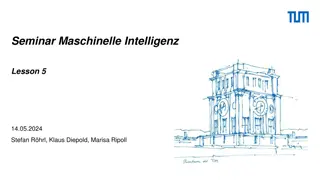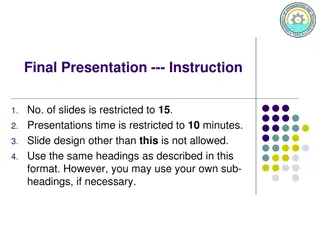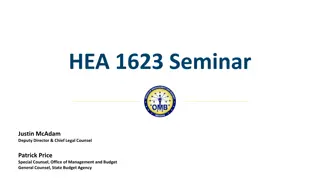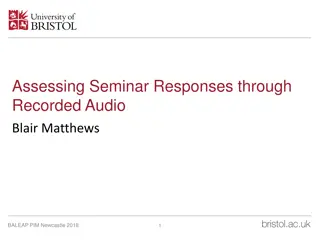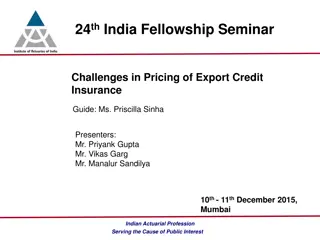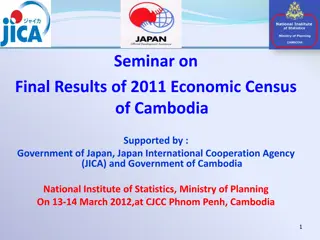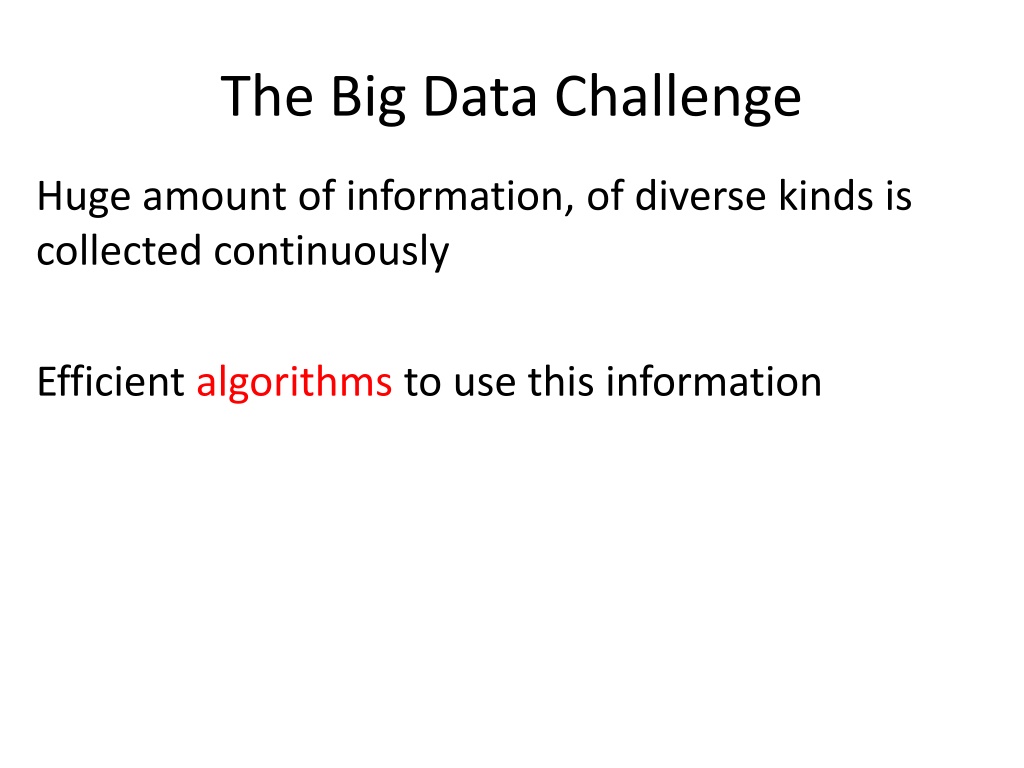
Data Challenge: Efficient Algorithm Solutions for Big Data
"Explore the implications, structures, and computations related to big data challenges, with a focus on efficient algorithms and data synopsis techniques. Discover how to handle vast amounts of information and make accurate estimations using synopsis structures."
Download Presentation

Please find below an Image/Link to download the presentation.
The content on the website is provided AS IS for your information and personal use only. It may not be sold, licensed, or shared on other websites without obtaining consent from the author. If you encounter any issues during the download, it is possible that the publisher has removed the file from their server.
You are allowed to download the files provided on this website for personal or commercial use, subject to the condition that they are used lawfully. All files are the property of their respective owners.
The content on the website is provided AS IS for your information and personal use only. It may not be sold, licensed, or shared on other websites without obtaining consent from the author.
E N D
Presentation Transcript
The Big Data Challenge Huge amount of information, of diverse kinds is collected continuously Efficient algorithms to use this information
Big Data Implications Many classic tools are not relevant Can t just throw everything into a DBMS Computational models: map-reduce (distributing/parallelizing computation) data streams (one or few sequential passes) Algorithms/machine learning Can t go much beyond linear processing Often need to trade-off accuracy and computation cost
Synopsis (Summary) Structures A small summary of a large data set that (approximately) captures some statistics/properties we are interested in. Examples: random samples, sketches/projections, histograms, classifier in ML Data ? Synopsis ?
Query a synopsis: Estimators From the synopsis ? we obtain an estimate ?(?) of a property/statistics/function ?(?) of the data ? Data ? Synopsis ? ?(?) ? ?(?)
Synopsis Structures Useful features: Easy to add an element Mergeable : can create summary of union from summaries of data sets Deletions/ undo support Flexible: supports multiple types of queries
Mergeability Data 1 Synopsis 1 Data 2 Synopsis 2 Synopsis 12 Data 1 + 2 Enough to consider merging two sketches
Streaming model Sequence of elements from some domain <x1, x2, x3, x4, ..... > Bounded storage: working memory << stream size usually O polylog n Fast processing time per stream element
What can we compute over a stream ? 32, 112, 14, 9, 37, 83, 115, 2, Some functions are easy: min, max, sum, We use a single register ?, simple update: Maximum: Initialize ? 0 For element ? , ? max ?,? Sum: Initialize ? 0 For element ? , ? ? + ? The synopsis here is a single value. It is also mergeable.
Frequent Elements 32, 12, 14, 32, 7, 12, 32, 7, 6, 12, 4, Elements occur multiple times, we want to find the elements that occur very often. Number of distinct element is ? Stream size is ?
Frequent Elements 32, 12, 14, 32, 7, 12, 32, 7, 6, 12, 4, Applications: Networking: Find elephant flows Search: Find the most frequent queries Zipf law: Typical frequency distributions are highly skewed: with few very frequent elements. Say top 10% of elements have 90% of total occurrences. We are interested in finding the heaviest elements
Frequent Elements: Exact Solution 32, 12, 14, 32, 7, 12, 32, 7, 6, 12, 4, Exact solution: Create a counter for each distinct element on its first occurrence When processing an element, increment the counter 14 7 6 4 12 32 Problem: Need to maintain ? counters. But can only maintain ? ? counters
Frequent Elements: Misra Gries 1982 32, 12, 14, 32, 7, 12, 32, 7, 6, 12, 4, Processing an element ? If we already have a counter for ?, increment it Else, If there is no counter, but there are fewer than ? counters, create a counter for ? initialized to ?. Else, decrease all counters by ?. Remove ? counters. 12 14 12 7 12 4 32 ? = 6 ? = 3 ? = 11
Frequent Elements: Misra Gries 1982 32, 12, 14, 32, 7, 12, 32, 7, 6, 12, 4, Processing an element ? If we already have a counter for ?, increment it Else, If there is no counter, but there are fewer than ? counters, create a counter for ? initialized to ?. Else, decrease all counters by ?. Remove ? counters. Query: How many times ? occurred ? If we have a counter for ?, return its value Else, return ?. This is clearly an under-estimate. What can we say precisely?
Misra Gries 1982 : Analysis How many decrements to a particular ? can we have ? How many decrement steps can we have ? Suppose total weight of structure (sum of counters) is ? Total weight of stream (number of occurrences) is ? Each decrement step results in removing ? counts from structure, and not counting current occurrence of the input element. That is ? + 1 uncounted occurrences. There can be at most ? ? ?+1decrement steps Estimate is smaller than true count by at most ? ? ?+?
Misra Gries 1982 : Analysis Estimate is smaller than true count by at most ? ? ?+? We get good estimates for ? when the number of occurrences ? ? ?+1 Error bound is inversely proportional to ? The error bound can be computed with summary: We can track ? (simple count), know ? (can be computed from structure) and ?. MG works because typical frequency distributions have few very popular elements Zipf law
Merging two Misra Gries Summaries [ACHPWY 2012] Basic merge: If an element ? is in both structures, keep one counter with sum of the two counts If an element ? is in one structure, keep the counter Reduce: If there are more than ? counters Take the ? + 1th largest counter Subtract its value from all other counters Delete non-positive counters
Merging two Misra Gries Summaries 7 6 14 12 14 32 Basic Merge: 12 14 7 6 32
Merging two Misra Gries Summaries 12 14 7 6 32 4th largest Reduce since there are more than ? = ? counters : Take the ? + 1th = 4th largest counter Subtract its value (2) from all other counters Delete non-positive counters
Merging MG Summaries: Correctness Claim: Final summary has at most ? counters Proof: We subtract the (? + 1)th largest from everything, so at most the ? largest can remain positive. Claim: For each element, final summary count is smaller than true count by at most ? ? ?+1
Merging MG Summaries: Correctness Claim: For each element, final summary count is smaller than true count by at most ? ? ?+1 Proof: Counts for element ? can be lost in part1, part2, or in the reduce component of the merge We add up the bounds on the losses Part 1: Total occurrences: ?1 In structure: ?1 Count loss: ?? ?? Part 2: Total occurrences: ?2 In structure: ?2 Count loss: ?? ?? ?+? ?+? Reduce loss is at most ? = (? + ?)th largest counter
Merging MG Summaries: Correctness Count loss of one element is at most ?? ?? ?+? ?+? +?? ?? + ?
Merging MG Summaries: Correctness Counted occurrences in structure: After basic merge and before reduce: ?1 After reduce: ? Claim: m1 Proof: ? are erased in the reduce step in each of the ? + 1 largest counters. Maybe more in smaller counters. + ?2 + m2 ? ? ? + 1 Count loss of one element is at most +?? ?? ?+? + ? ?? ?? ?+? ? ?+???+ ?? ? at most? ? ? + 1 uncounted occurrences
Using Randomization Misra Gries is a deterministic structure The outcome is determined uniquely by the input Usually we can do much better with randomization
Randomization: Quick review Random variable (discrete or continuous) ? Probability Density Function (PDF) ??(?) : Probability/density of? = ? Properties: ??? ? Cumulative Distribution Function (CDF) ? ??? ?? : probability that ? ? Properties: ??? monotone non-decreasing from 0 to 1 ??? ?? = ? ??? =
Quick review: Expectation Expectation: average value of ? : ? ??? ?? ? = ? ? = Linearity of Expectation: ?[?? + ?] = ??[?] + ? For random variables ??, , ??, , ??, , . . . . . . , , ?? ? ? ? ?? = ?[??] ?=? ?=?
Quick review: Variance Variance ? ? = ??= ?[ ? ?)? (? ?)???? ?? = Useful relations: ??= ? ?? ?? ?[?? + ?] = ???[?] The standard deviation is ? = Coefficient of Variation? ?[?] ?
Quick review: CoVariance CoVariance (measure of dependence between two random variables) ?,? Cov ?,? = ? ?,? = ? ? ?? = ? ?? ???? ? ?? ?,? are independent ? ?,? = ? Variance of the sum of ??,??, ,?? ? ? ? ? ? ?? = ???[??,??] = ?[??] + ???[??,??] ?=? ?,?=? ?=? ? ? When (pairwise) independent
Quick Review: Estimators A function ? we apply to a random synopsis ? in order to obtain an estimate ?(?) of ?(?) Errorerr ? = ? ? ?(?) Bias bias ? = E[err ? ] = ?[ ?] ?(?) When Bias = 0 estimator is unbiased Mean Square Error (MSE): MSE ? = E err ? Root Mean Square Error (RMSE): ??? 2 2 = ? ? + Bias ?
Back to stream counting 1, 1, 1, 1, 1, 1, 1, 1, Count: Initialize ? 0 For each element, ? ? + ? Register (our synopsis) size (bits) is log2 ? where ? is the current count Can we use fewer bits ? Important when we have many streams to count, and fast memory is scarce (say, inside a backbone router) What if we are happy with an approximate count ?
Morris Algorithm 1978 The first streaming algorithm Idea: track ??? ?instead of ? Use ??? ??? ?bits instead of ??? ? bits
Morris Algorithm Maintain a log counter ? Increment: Increment with probability ? ? Query: Output ? = ?? ? 1, 1, 1, 2, 3, 1, 1, 4, 1, 5, 1, 6, 1, 7, 1, 8, Stream: Count ?: 1 2 1 2 1 4 1 4 1 4 1 4 1 8 1 8 1 ? = 2 ?: Counter ? : 0 2 2 3 3 1 1 2 2 Estimate ? : 0 7 3 3 1 7 1 3 3
Morris Algorithm: Unbiasedness When ? = ?, ? = ?, estimate is ? = ?? ? = ? When ? = ?, with ? =1 2 , ? = ? , ? = ? with ? =1 Expectation: E ? =? ? = ?,?,? by induction . 2 , ? = ? , ? = ?? ? = ? ? ? +? ? ? = ?
Morris Algorithm: Unbiasedness ?? is the random variable corresponding to the counter ? when the count is ? We need to show that E ? = ? ??? ? = ? That is, to show that ? ??? = ? + ? ? ??? = ???? ?? ?= ? ? ????? ?= ?] ? ? We next compute: ? ????? ?= ?]
Morris Algorithm: Unbiasedness Computing ? ????? ?= ?]: with probability ? = ? ?: ??= ? + ?, 2??= 2?+1 with probability ? = ? ? ?: ??= ?, 2??= 2? ? ????? ?= ?] = ? ? ???+ ? ???+? = ?? ? + ? = ??+ ?
Morris Algorithm: Unbiasedness ? ????? ?= ?] = ??+ ? ? ??? = ???? ?? ?= ? ? ????? ?= ?] ? ? ???? ?? ?= ? (??+?) = ? ? ???? ?? ?= ? (?? ?) + = ???? ?? ?= ? ? ? ? ? ? ? = ? ??? ? ? = ? ? by induction hyp. = ? + ?
Morris Algorithm: Variance How good is the estimate? The r.v. s ? = 2?? 1 and ? + 1 = 2?? have the same variance V ? = ?[ ? + 1] ? ? + 1 = ? 22?? (? + 1)2 We can show ? 22?? =3 2?2+3 2? + 1 This means ? ? 1 2?2 and CV = 1 ? 2 How to reduce the error ?
Morris Algorithm: Reducing variance 1 ? ? = 2 1 2?2 and CV = 1 ? 2 Dedicated Method: Base change IDEA: Instead of counting ?????, count ????? Increment counter with probability ? ? When ? is closer to 1, we increase accuracy but also increase counter size.
Morris Algorithm: Reducing variance 2 ? ? = 2 1 2?2 and CV = 1 ? 2 Generic Method: Use ? independent counters ??,??, ,?? Compute estimates ??= ??? ? Average the estimates ? = ?=? ? ?? ?
Reducing variance by averaging ? (pairwise) independent estimates ?? with expectation ? and variance ??. ? ?=? ?? The average estimator ? = ? ? =? ? ?? =? Expectation: ? ? ? ?=? ??? = ? ???=?? ? ?=? ? ? ? ? ? ? Variance: ? ?? = ? CV : ? ? decreases by a factor of ?
Counting Distinct Elements 32, 12, 14, 32, 7, 12, 32, 7, 6, 12, 4, Elements occur multiple times, we want to count the number of distinct elements. Number of distinct element is ? (= 6 in example) Number of elements in this example is 11
Counting Distinct Elements: Example Applications 32, 12, 14, 32, 7, 12, 32, 7, 6, 12, 4, Networking: Packet or request streams: Count the number of distinct source IP addresses Packet streams: Count the number of distinct IP flows (source+destination IP, port, protocol) Search: Find how many distinct search queries were issued to a search engine each day
Distinct Elements: Exact Solution 32, 12, 14, 32, 7, 12, 32, 7, 6, 12, 4, Exact solution: Maintain an array/associative array/ hash table Hash/place each element to the table Query: count number of entries in the table Problem: For ? distinct elements, size of table is (?) But this is the best we can do (Information theoretically) if we want an exact distinct count.
Distinct Elements: Approximate Counting 32, 12, 14, 32, 7, 12, 32, 7, 6, 12, 4, IDEA: Size-estimation/Min-Hash technique : [Flajolet-Martin 85, Cohen 94] Use a random hash function ? ?[0,1] mapping element IDs to uniform random numbers in [0,1] Track the minimum ? Intuition: The minimum and ? are very related : With ? distinct elements, expectation of the minimum E min x = ?+1 Can use the average estimator with ? repetitions 1
Bibliography Misra Gries Summaries J. Misra and David Gries, Finding Repeated Elements. Science of Computer Programming 2, 1982 http://www.cs.utexas.edu/users/misra/scannedPdf.dir/FindRepeatedElements.pdf Merging: Agarwal, Cormode, Huang, Phillips, Wei, and Yi, Mergeable Summaries, PODS 2012 Approximate counting (Morris Algorithm) Robert Morris. Counting Large Numbers of Events in Small Registers. Commun. ACM, 21(10): 840- 842, 1978 http://www.inf.ed.ac.uk/teaching/courses/exc/reading/morris.pdf Philippe Flajolet Approximate counting: A detailed analysis. BIT 25 1985 http://algo.inria.fr/flajolet/Publications/Flajolet85c.pdf Merging Morris counters: these slides Approximate distinct counting P. Flajolet and G. N. Martin. Probabilistic counting. In Proceedings of Annual IEEE Symposium on Foundations of Computer Science (FOCS), pages 76 82, 1983 E. Cohen Size-estimation framework with applications to transitive closure and reachability, JCSS 1997




